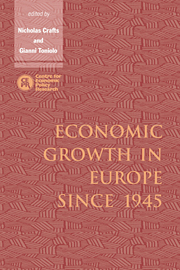Book contents
- Frontmatter
- Contents
- List of figures
- List of tables
- Preface
- List of contributors
- 1 Postwar growth: an overview
- 2 Institutions and economic growth: Europe after World War II
- 3 The varieties of Eurosclerosis: the rise and decline of nations since 1982
- 4 Why the 1950s and not the 1920s? Olsonian and non-Olsonian interpretations of two decades of German economic history
- 5 Convergence, competitiveness and the exchange rate
- 6 British economic growth since 1945: relative economic decline … and renaissance?
- 7 Economic growth in postwar Belgium
- 8 France, 1945–92
- 9 Economic growth and the Swedish model
- 10 Characteristics of economic growth in the Netherlands during the postwar period
- 11 Portuguese postwar growth: a global approach
- 12 Growth and macroeconomic performance in Spain, 1939–93
- 13 Irish economic growth, 1945–88
- 14 Italy
- 15 West German growth and institutions, 1945–90
- 16 An exercise in futility: East German economic growth and decline, 1945–89
- 17 Postwar growth of the Danish economy
- 18 Reflections on the country studies
- Index
18 - Reflections on the country studies
Published online by Cambridge University Press: 04 August 2010
- Frontmatter
- Contents
- List of figures
- List of tables
- Preface
- List of contributors
- 1 Postwar growth: an overview
- 2 Institutions and economic growth: Europe after World War II
- 3 The varieties of Eurosclerosis: the rise and decline of nations since 1982
- 4 Why the 1950s and not the 1920s? Olsonian and non-Olsonian interpretations of two decades of German economic history
- 5 Convergence, competitiveness and the exchange rate
- 6 British economic growth since 1945: relative economic decline … and renaissance?
- 7 Economic growth in postwar Belgium
- 8 France, 1945–92
- 9 Economic growth and the Swedish model
- 10 Characteristics of economic growth in the Netherlands during the postwar period
- 11 Portuguese postwar growth: a global approach
- 12 Growth and macroeconomic performance in Spain, 1939–93
- 13 Irish economic growth, 1945–88
- 14 Italy
- 15 West German growth and institutions, 1945–90
- 16 An exercise in futility: East German economic growth and decline, 1945–89
- 17 Postwar growth of the Danish economy
- 18 Reflections on the country studies
- Index
Summary
Introduction
The advent of new growth theory together with continuing improvements in historical statistics have combined to allow the authors of the case studies in this volume to develop a clearer and sharper picture of the process of economic growth in postwar Europe. In this final chapter, we wish to summarize the main messages which come from these studies. In doing so we wish not only to underline key insights for economic history students, but also to highlight some relevant findings for future work in growth economics.
Research in growth economics since the mid-1980s had centred on models which feature endogenous productivity growth. Sustained growth of real GDP/person is seen as coming from investments in human and physical capital and/or profitmotivated production and use of knowledge. Technological change is no longer consigned to an exogenous Solow residual, even though for many purposes it is still useful to measure total factor productivity (TFP) growth. In turn, it follows that the potential impact of institutional arrangements and policy on growth outcomes must now be taken seriously, rather than being confined to transitional dynamics, as in the traditional neoclassical growth model.
A much discussed aspect of growth is the catch-up of leading countries by followers, a familiar theme in European economic history at least since Gerschenkron (1962). It has become increasingly clear that catch-up growth is neither automatic nor universally achieved, but requires what Abramovitz (1986) called ‘social capability’, also making this type of productivity growth endogenous.
- Type
- Chapter
- Information
- Economic Growth in Europe since 1945 , pp. 576 - 581Publisher: Cambridge University PressPrint publication year: 1996
- 1
- Cited by



